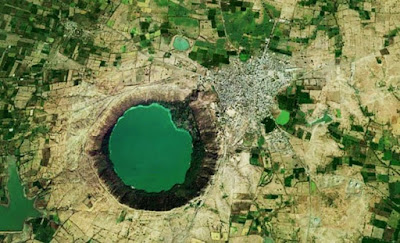2020 - expect the unexpected | Lake Lonar turns pink
500 kms away from Mumbai, situated in the Buldhana district, is one of the most mysterious lakes of the world - the Lonar lake. Formed over 50,000 years ago by a meteorite collision with earth, this is one of the four known, hyper-velocity, impact craters in basaltic rock anywhere on Earth. The other three being in southern Brazil.
Recently it the colour of the lake turned pink and because of the ongoing lockdown phase, the members of the Lonar lake conservation have been unable to examine this change. The same reason also rules out the speculation of any human intervention in the incident.
A recent image of Lake Lonar, Bhuldhana district
This is the reason why Lonar lake with all its mysteries and myths has resurfaced everywhere. What the members do speculate, is that, due to the lack of rains the salinity of the lake has increased, which must have reacted with the algae in the lake, to cause the colour to change into the hues of red. In 2015 the colour of lake Tuz Golu in central Turkey turned blood red due to similar reasons, but until it was figured out, people speculated it to be a biblical plague.
Lake Tuz Golu, Turkey
Now, our very own Lonar lake has also been enigmatic since the beginning of time. Reminding you that it is over 50,000 years old, the most recent research estimating its age somewhere between 47,000 to 57,000 years, while civilisation itself is only about 60,000 years old. It was earlier considered to have been of volcanic origin, but later, it was established that the real cause was either a comet or asteroid collision with earth. Talking about asteroids, we've had a lot of that this year, the most recent being 2020 LD - the biggest asteroid to have passed within the moon's orbit since 2011. It passed undetected on June 5 only to have been noticed on June 7.
Geologists, ecologists, archeologists, naturalists and astronomers have all gaped and researched extensively on the many aspects of this crater lake ecosystem. Many contemporary believers also theorise the crater to have been caused due to a UFO landing.
Ariel view of Lake Lonar, Buldhana district
Lonar lake derives its name from a mythical demon named Lonasur. It is said that the dent was the resting place of the demon and after Lord Krishna killed the demon the blood spilled all over and till today causes the water to be murky. The ancient religious settings have made Lonar lake an interesting tourist attraction with the best of the early Hindu architectural marvels.
The lake is surrounded by ancient ruins of many temple one of the most famous being that of Daitya Sudan, built in honour of Krishna's victory over Lonasur. Then there is the partially submerged Shankar Ganesh Temple with a rectangular idol of Lord Shiva. About 700 m away from the main lake is Ambar crater lake, believed to be caused by a splinter of the same meteor, around which is the Motha Maruti temple that houses the mythical idol that is said to have been made with the material of the same meteor. Lastly the Gomukh temple offers a spectacular view along with an opportunity to jump into the fresh spring stream (not that we are jumping anytime soon).
The Lonar Lake usually appears green due to the dense blooms of cyanobacteria
The lake has been mentioned in ancient scriptures such as the largest Mahapurana - Skanda Purana, one of the eighteen major Puranas - Padma Purana and the 16th century detailed document - Ain-i-Akbari or Administration of Akbar. The Ain-i-Akbari states:
These mountains produce all the requisites of making glass and soap. And here are saltpetre works which yields a considerable revenue to the State, from the duties collected. On these mountains is a spring of salt water, but the water from the centre and the edges is perfectly fresh.
The Lonar Lake has witnessed many reigns from Ashoka's Maurya Empire, to the Satavahana Empire of the Andhras, to the Chalukyas to the Rashtrakutas. Trade prospered during the period of Mughals, Yadavas, Nizams and the British.
The Lonar lake was created due to an extra-terrestrial material, has survived centuries and calamities yet been indestructible, has witnessed so many dynasties, is home to most diverse species of fauna thus helping the ecosystem and despite years of research, speculations and superstitions continues to be a mystery. Can you imagine how antique it is, how many secrets it holds, how truly inexplicable it is. One of the first things I want to do post lockdown is to go to lake Lonar at Buldhana district.
P.S - I throughly enjoyed writing this post. I love mysteries.







Superb article. Enjoyed reading it
ReplyDelete